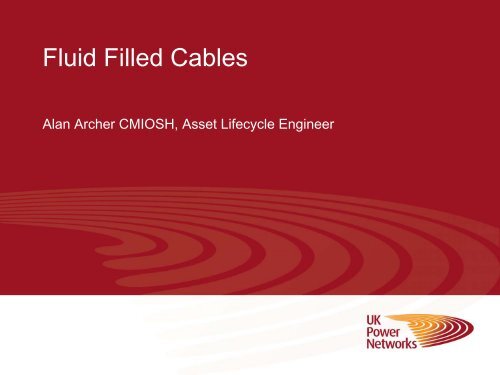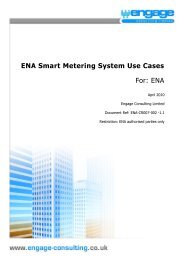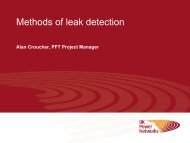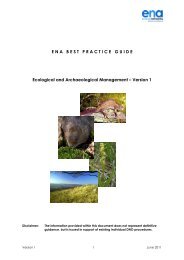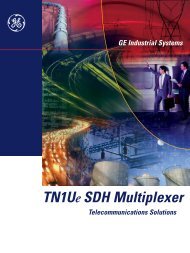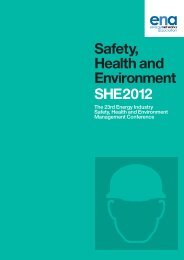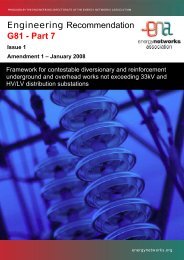Fluid-filled cables overview - Energy Networks Association
Fluid-filled cables overview - Energy Networks Association
Fluid-filled cables overview - Energy Networks Association
Create successful ePaper yourself
Turn your PDF publications into a flip-book with our unique Google optimized e-Paper software.
<strong>Fluid</strong> Filled Cables<br />
Alan Archer CMIOSH, Asset Lifecycle Engineer
Overview<br />
• Function of cable fluid in fluid <strong>filled</strong> <strong>cables</strong><br />
• Types of fluids used<br />
• Movement of fluid in cable circuits
<strong>Fluid</strong> Filled Cable Design<br />
• For fluid <strong>filled</strong> <strong>cables</strong> of all voltages<br />
(33, 66, 132, 275 and 400kV) to<br />
operate reliable they must be <strong>filled</strong><br />
with a cable fluid which is<br />
maintained under an appropriate<br />
positive pressure.<br />
• 1920 – Luigi Pirelli produce first<br />
pressurised fluid <strong>filled</strong> cable which<br />
operated at 80kV<br />
• 1928 – First fluid <strong>filled</strong> cable in UK<br />
which operated at 66kV<br />
• 1969 – First 400kV fluid <strong>filled</strong> cable
<strong>Fluid</strong> Filled Cable Design<br />
Metallic Sheath<br />
Conductor<br />
Butt Gap<br />
Cable <strong>Fluid</strong><br />
Insulation<br />
• The fluid forms an integral part of the <strong>cables</strong> insulation and prevents the<br />
formation of voids in the lapped papers around the conductor.<br />
• In addition the fluid aids the conduction of heat away from the conductor<br />
allowing the cable to be run more efficiently than a cable without it.
Types of Cable <strong>Fluid</strong><br />
• <strong>Fluid</strong> <strong>filled</strong> <strong>cables</strong> have been used in the UK for over 80 years with some<br />
circuits installed in the 1930’s still operating successfully today without any<br />
deterioration.<br />
• Over the years a number of different type of fluid have been used:<br />
– Before 1965 - a heavy mineral fluid with low biodegradability;<br />
– 1965 to 1985 – a synthetic fluid made as a by product of the detergent<br />
industry;<br />
– 1986 to today – a light synthetic biodegradable fluid.<br />
• Today most Distribution and Transmission Operators use a single product<br />
(T3788) produced in the UK by a company called H & R Chempharm Ltd.<br />
• Most cable circuits, except those recently installed contain a mix of all three<br />
of the above fluids.
System Design and <strong>Fluid</strong> Movement<br />
• The fluid contained within a fluid <strong>filled</strong> cable has to be kept at a<br />
positive pressure under all conditions of loading and ambient<br />
temperature change.<br />
• The pressure used depends on a number of factors:<br />
–Voltage and size of cable;<br />
–The length of the cable;<br />
–The route the cable follows;<br />
–Whether the cable has a leak.<br />
•The pressure in the system is designed to ensure that the whole<br />
cable route is maintained at an adequate pressure ( 4 to 70 PSI) to<br />
ensures that it operates correctly.
System Design and <strong>Fluid</strong> Movement<br />
Typical fluid <strong>filled</strong> cable circuit<br />
Oil Feeding Equipment Joint Stop Joint<br />
Termination<br />
• The type of fluid <strong>filled</strong> cable used in the UK is termed a “Static” system.<br />
• This means that under normal conditions the fluid in the system is total<br />
contained.<br />
• When the cable is heated either by the amount of current passing through it<br />
or the ambient air temperature the fluid expands and consequently moves.
System Design and <strong>Fluid</strong> Movement<br />
•To cope with changes in pressure a fluid<br />
reservoir is fitted to the ends of each section<br />
of the circuit.<br />
•<strong>Fluid</strong> movement =<br />
•[Cexp x (δTcxVc)x(δTixVi)x(δTdxVd)]xL<br />
•Where<br />
•Cexp = Coefficient of expansion of fluid<br />
•δTc, δTi, δTd = Temperature rise in<br />
conductor, insulation and ducts<br />
•Vc, Vi, Vd = Volume of fluid in conductor,<br />
insulation and ducts<br />
•L = Length of cable<br />
To Alarms<br />
Pressure element<br />
Pressure Gauge<br />
Valve<br />
Insulated<br />
Link<br />
To Cable<br />
System<br />
De-gassed<br />
Cable<br />
<strong>Fluid</strong>
System Design and <strong>Fluid</strong> Movement<br />
•This graph illustrate the<br />
changes of pressure that<br />
can be seen in a cable.<br />
•At point A (08:00AM) the<br />
pressure measured is<br />
approximately 18PSI.<br />
•At point B (12:30PM) the<br />
pressure measured is<br />
approximately 21PSI.<br />
•This change in pressure<br />
3 PSI which equates to<br />
15 litres of fluid moving<br />
from the cable into the<br />
tanks.<br />
A<br />
B
System Design and <strong>Fluid</strong> Movement<br />
•This same graph also<br />
illustrate the changes of<br />
pressure that can be seen<br />
in a leaking cable that is<br />
pumped.<br />
•At point C (07:00AM) the<br />
pressure measured is<br />
approximately 12PSI.<br />
•At point D (13:30PM) the<br />
pressure measured is<br />
approximately 24PSI.<br />
•This change in pressure 12<br />
PSI which equates to 26<br />
litres of fluid being put into<br />
the cable via the tanks.<br />
C<br />
D
Summary of cable design<br />
•<strong>Fluid</strong> <strong>filled</strong> <strong>cables</strong> rely on the presence of pressurised able fluid to work<br />
efficiently.<br />
• Three different types of cable fluid have been used over the years, with the<br />
material used since 1986 being the least harmful to the environment.<br />
•The fluid within a cable system normally only moves within the confines of the<br />
cable and the pressure tanks that feed it.<br />
•<strong>Fluid</strong> movement is as a result of the cable being heated by the current it is<br />
passing or the ambient temperature in the environment.<br />
•Under normal conditions the amount of fluid that moves can be measured in<br />
10’s of litres.
Typical installation profile<br />
•This diagram shows the cross section<br />
of a typical cable installation.<br />
•Today <strong>cables</strong> are installed within<br />
ducting to allow easier replacement.<br />
•Existing FFC were mostly installed<br />
direct to ground, in a bed of sand<br />
protected by concrete cable markers<br />
or tiles.<br />
•Cables can be buried from 1m to<br />
more than 4m.<br />
•Access is difficult due to other<br />
services and utilities.<br />
•Access impeded by red routes and<br />
road opening notices etc.
• Thank You<br />
Any Questions


